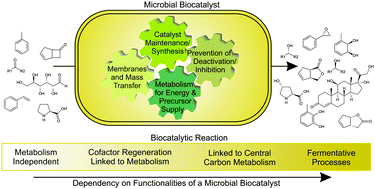During the last decades, biocatalysis became of increasing importance for chemical and pharmaceutical industries. Regarding regio- and stereospecificity, enzymes have shown to be superior compared to traditional chemical synthesis approaches, especially in C–O functional group chemistry. Catalysts established on a process level are diverse and can be classified along a functional continuum starting with single-step biotransformations using isolated enzymes or microbial strains towards fermentative processes with recombinant microorganisms containing artificial synthetic pathways. The complex organization of respective enzymes combined with aspects such as cofactor dependency and low stability in isolated form often favors the use of whole cells over that of isolated enzymes. Based on an inventory of the large spectrum of biocatalytic C–O functional group chemistry, this review focuses on highlighting the potentials, limitations, and solutions offered by the application of self-regenerating microbial cells as biocatalysts. Different cellular functionalities are discussed in the light of their (possible) contribution to catalyst efficiency. The combined achievements in the areas of protein, genetic, metabolic, and reaction engineering enable the development of whole-cell biocatalysts as powerful tools in organic synthesis.

You have access to this article
 Please wait while we load your content...
Something went wrong. Try again?
Please wait while we load your content...
Something went wrong. Try again?


 Please wait while we load your content...
Please wait while we load your content...